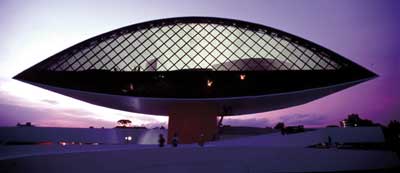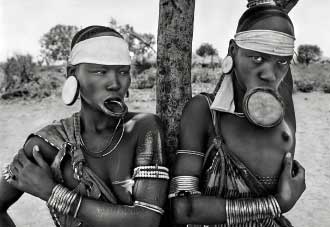
When you arrive at Curitiba, capital of Parana State, the visit to the Museum Oscar Niemeyer is one of the first calls of those who inhabit the city. Besides being an impressive and unique building, is also named after the architect who designed Brasilia icons and other buildings not only in the country.
In the building it is perceived architecture designed to art, which consists of two buildings of thirty five thousand square meters, of which nineteen thousand are intended for exhibition areas. The first was designed in 1967 and conceived as education institute; years later, to be adapted to the new role of museum, Niemeyer gives it its personal stamp and build a new annex building with eye shape that denotes his passion for the curves. In the city it is known as the Ojo Museum, which allocated several readings ranging from understanding the way an imitation of the araucaria or Paraná pine -tree identity of the state or the arc that describes the dancer in his hands, image on the footwall. It is also the eye that observes the city where every person can be a main character. As artistic element has the ability to give a new meaning from personal looks that goes always beyond the intent of the creator himself.
Oscar Niemeyer was born in Rio de Janeiro in 1907 and died in 2012. He is considered one of the most influential artists of international modern architecture can be found in the concrete an endless range of possibilities that become art and which constituted his legacy. Curves were his fascination element and the key to his works and designs, where everything projected movement as immovable fierce resistance hardness that always transmits the cement and steel, "It is the right angle that attracts me, nor straight, hard, inflexible line created by man. What attracts me is the free and sensual curve, the curve I find in the mountains of my country, in the sinuous course of its rivers, in the waves, in the body of the woman preferred. Curve is made the whole universe, the curved universe of Einstein. "
His works are born from that creative and dynamic thinking. So they get to us to transcend him in time as witnesses of his passage through life. The most prominent among them are the city of Brasilia as the new capital of the country; the Museum of Contemporary Art in Niterói, that he conducted when he was 100 years old and consists of a building sixteen meters high and a dome with a diameter of fifty; the Metropolitan Cathedral of Brasilia, completed in 1970, which consists of a huge asymmetric structure that culminates with a glass roof that invites us to look at the universe; the National Congress opened in 1960, headqueartes of the federal legislature, which marked the transfer of the capital to Brasilia, consisting of two hemispheres with two office towers; the Planalto Palace, headquarters of the executive branch of the Federal Government, whose construction began in 1958 and consists of four floors with an area of ??36 000 square meters; and the UN headquarters in New York, which he conducted in 1952 as part of a famous group of architects.
Niemeyer tirelessly sought to convey with his works an image of modernity. Even the most solid structures succumbed to the use of lines and waves that finally transmitted sinuous movements: "This is the architecture that I do, looking for new different ways. The surprise is key in all art. The artistic ability of reinforced concrete is so fantastic ... it is the way to go. The curves are the essence of my work, since they are the essence of Brazil, pure and simple. I am first of all Brazilian, then an architect. I can not separate the two of them. "
Oscar Niemeyer Museum is a constant invitation to the encounter with the culture. In its spaces remain exposed the most diverse elements of visual arts, design and architecture. The exhibition Genesis is exhibited in one of its rooms until April, by Sebastian Salgado, contemporary Brazilian photographer who holds, since 1998, the Prince of Asturias Award for the Arts.

The exhibition consists of 245 large-format images that favor black and white photograph and it is the result of eight years of work in which the artist captured the nature of five world regions. It is essentially a call for the preservation of nature putting emphasis on humans.
The images take you to mountains, deserts, valleys, sunny environments or lined by snow; various animals that are captured in the most diverse relationships between them; the harshness of the climate, the hostility of nature and, somehow, the resistance of entire peoples who survive the intense cold, the most dense jungle, the bleaker desert. The being is gaining space and is revealed in the most successful pictures, to become protagonist.
These photographs mix elements that provide plural speeches. The body is also an expressive tool: half naked, carefully dressed, painted, drawn up to achieve being lost within nature itself.
The pictures take us to places where it seems that life is not possible, to indigenous groups that look like frozen in time, but which reveal their daily lives, impacting ours, which seems inevitably crossed by the technology in the most intimate and habitual actions.
The bodies of men and women appear in a symbolic dimension, introducing rites that survive the years of "civilization", especially from the Western perspective of civilization in which "the other" resembles the origins of the human species and from which the rhetorical questions of astonishment rumble: "Is it possible this reality parallel to ours, in the twenty-first century ?, could this be called culture of resistance, preservation of identities?".
The images bring us their everyday life to mean, in the societies shown, the various modes of male domination, the phallocentric culture presented by crude phallic costumes which vary denoting hierarchies within groups. The markedly gendered roles where women and adolescents 'disfigure' parts of their bodies to give them beauty in preparation to attract the husband, the woman exposed to male choice, devoid of all power, and a concept of beauty playing with our canons and disassemble them.
In the center of everything, the diverse and unequal humanity coexist with an animal and plant world, unsuspected for those who have only had the vision of its socio-geographic boundaries. Including myself, now closer to other realities through a sensitive lens to what we are, a small part of the whole universal.










